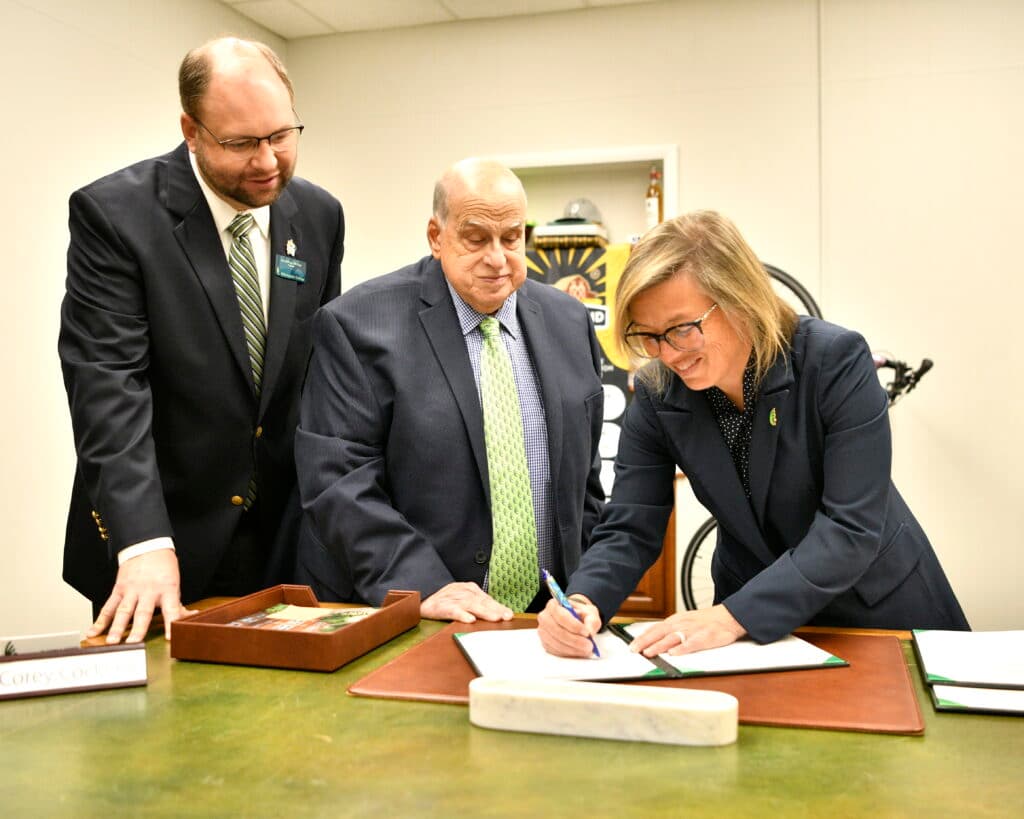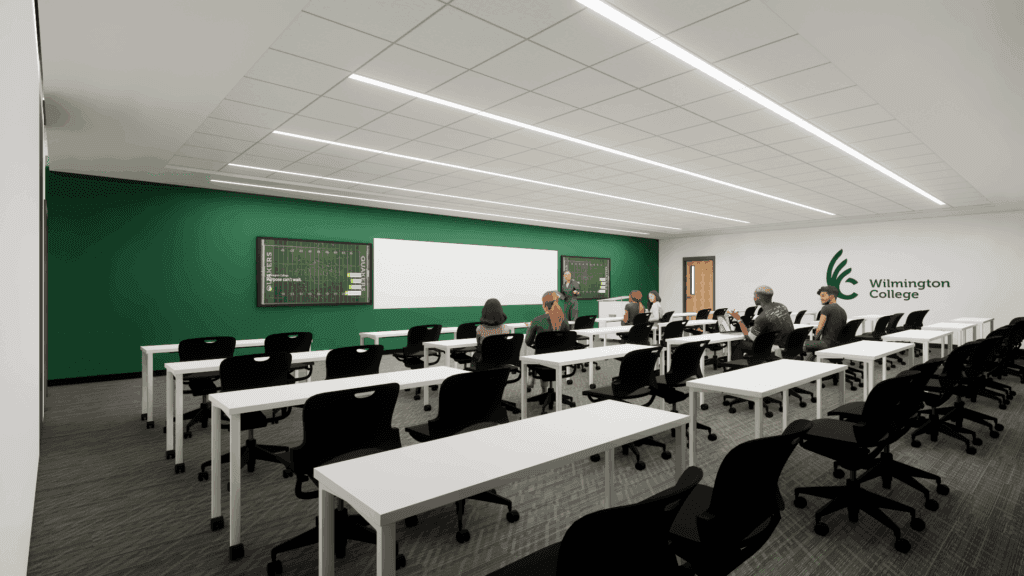WC Purchases BrightFarms Property
Wilmington College announced its recent purchase of the BrightFarms facility in Wilmington and revealed plans to revitalize the shuttered space into the Wilmington College Agriscience Complex. The acquisition includes the existing 120,000 square-foot hydroponic greenhouse, as well as an adjacent 20 acres bordering the College’s 267-acre Academic Farm.
Securing this facility represents a significant step in the College’s strategic vision associated with its marquee agriculture program, which, this fall, welcomed one of its largest incoming classes ever. Agriculture concentrations comprise the largest academic area at WC, accounting for a third of the institution’s main campus student enrollment.
The College plans to transform the former commercial greenhouse into the Wilmington College Agriscience Complex, a living-learning laboratory fewer than three miles from the main campus. It will integrate crop science, animal science, agribusiness and food systems under one roof. This revitalized facility will include classrooms and laboratory renovations and an upgraded greenhouse infrastructure to support advanced agricultural research, sustainability initiatives and workforce training. A portion of the greenhouse can be renovated into a livestock handling facility that supports training in animal nutrition, reproduction and pre-veterinary science. Also, a 120’ x 240’ livestock and equine show arena will be constructed on the property.
College officials expect the repurposing of the greenhouse to begin as soon as possible, so students can start using the Agriscience Complex as early as fall 2026.

PHOTO: Board of Trustees members Jonathan McKay (left) and David Raizk witness President Corey Cockerill signing documents for the College to take ownership of the former Bright Farms property
President Corey Cockerill said the Agriscience Complex will be a “game-changer” that represents one of the boldest moves in the nearly 80-year history of WC’s agriculture program. “The facility will serve as a hub for hands-on learning, applied research and community engagement,” she said. “A place where students train across livestock production, pre-veterinary science, meat science, agribusiness and food systems, while also advancing solutions in sustainability and food security.”
Cockerill added that the Agriscience Complex will play a key role in training for agricultural careers in Ohio’s $124 billion agriculture industry, which she said is at a critical crossroads. “Rising food insecurity, rapid technological change and the generational transfer of knowledge as farmers retire have created an urgent demand for a workforce prepared to meet today’s — and tomorrow’s — agricultural challenges.”

PHOTO: This rendering features the Livestock Show Arena, which will have seating for up to 1,000 and accommodate the return of the Aggies’ Judging Contest to Wilmington.
BrightFarms opened its $10 million greenhouse at 780 Davids Drive in 2018 as a facility for growing salad greens, herbs and tomatoes year-round for regional distribution.
T. Alex Beres, executive director of the Clinton County Port Authority, said the College’s purchase and redevelopment of the BrightFarms property represents the kind of strategic investment that drives sustainable economic growth in the county. “By reimagining the recently vacated greenhouse into a state-of-the-art agricultural center, the College is creating a vital community asset that enhances the diversity of our economic base,” he said, noting the Port Authority maintained active communication with the facility’s prior ownership and other entities, and managed existing economic development agreements to ensure this transfer and redevelopment could happen quickly and seamlessly.
The timing of the property’s availability coincided with the College’s ambition to grow its agriculture program. WC has been raising funds for a proposed agriculture pavilion adjacent to its Equine Center on Fife Ave. Ultimately, the proposed pavilion project has evolved to what the College realized could be accomplished — for less money — at the former BrightFarms property. Fundraising continues for, now, the Wilmington College Agriscience Complex.
“We still need financial support to develop and expand the property for a truly integrated agricultural complex,” the president added, while noting the Board of Trustees gave the green light to ready the facility for student use by fall 2026.
The greenhouse features existing offices, restrooms, a paved driveway and parking lot, commercial-grade utilities, ADA accessibility and other professional spaces that can be readily repurposed into classrooms and labs. Also, BrightFarms had excavated and prepared land for a future facility expansion, so the space for WC’s livestock show arena enjoys construction-ready status.
The arena, which will have seating for up to 1,000, will be a venue capable of hosting statewide livestock and equestrian competitions, FFA and 4-H events, and applied learning workshops. The WC Aggies student organization has hosted an annual high school judging competition (livestock, equine, poultry and agronomy) for nearly seven decades. Attracting more than 1,500 competitors in recent years, the Aggies’ Judging Contest long ago outgrew local facilities and relocated to Clark County. Bringing this popular event back to Wilmington, where the College’s impressive new facilities will be on display, is expected to have a significant effect on student recruitment.
Adam Lohrey, vice president for enrollment management and marketing, concurred with Cockerill’s description of the Agriscience Complex as a “game-changer.” He noted this “incredible expansion” of facilities will allow the College to continue accelerated growth in enrollment by providing an industry-leading learning environment. “Our reputation in the agriculture industry is grounded in the preparation of students through experiential learning,” he added. “The complex will empower faculty to prepare students for impact on the agriculture industry. It demonstrates our commitment to many future generations of highly educated agriculture leaders.”
J. Wynn Alexander, vice president for academic affairs and dean of faculty, said the College’s investment in the complex comes at a time of increased interest and institutional growth in the agriculture program, while the growth in agricultural careers and the importance of agricultural education is at an all-time high.
“The number of ag students has literally outgrown our classrooms, faculty resources and laboratory spaces for the institution to maintain the applied nature, which is one of the hallmarks of a Wilmington College education,” Alexander said. “This acquisition will not only serve our existing students but will allow us to grow to expand our agricultural outreach, broaden our educational portfolio of programs and provide workforce development opportunities that will serve the agricultural needs of the future.
“This is the right purchase, at the right time, for the right reasons.”

PHOTO: A typical classroom in the Agriscience Complex is featured in this rendering.
Indeed, building the Agriscience Complex is informed by the College’s strategic plan, In Common Cause, which features seven pillars for guiding the institution from 2024 through 2027. One pillar specifies “elevating agriculture to advance signature curricular and co-curricular opportunities locally, regionally and on a global scope.”
Dr. Chad McKay, associate professor, area coordinator for agriculture and Endowed Chair of Agribusiness and Leadership, noted the purchase of BrightFarms “marks a new era” for agriculture at WC and dovetails well with the College’s introduction of a Master of Science in Agriculture degree program starting next fall. “It’s an era where innovation meets hands-on learning in the pursuit of a more sustainable future,” he said. “It reflects our commitment to preparing students not just to work in agriculture, but to shape its future, no matter if you were born and raised on a farm or if your first experience with agriculture is our courses. There is something for everyone interested in agriculture at Wilmington College.”
McKay is also a WC alumnus who’s aware of the venerable program’s many milestones since its founding in 1947, growing from the original animal science curriculum to six academic concentrations, to the largest major at the College, “The building of the Wilmington College Agriscience Complex is a testament to how far our agricultural roots have grown while still staying true to hands-on learning and community values,” he added. “It's inspiring to see the next generation of WC students gaining opportunities that will keep our legacy thriving and our future bright.”
TOP PHOTO: The architect’s rendering of the Wilmington College Agriscience Complex features the renovated existing building and the proposed livestock show arena.
